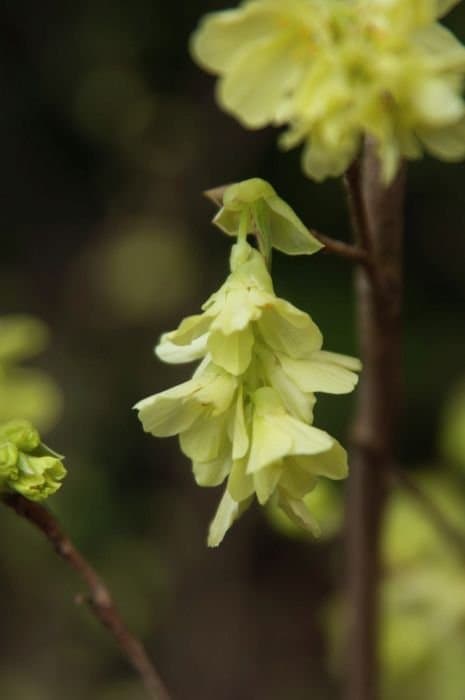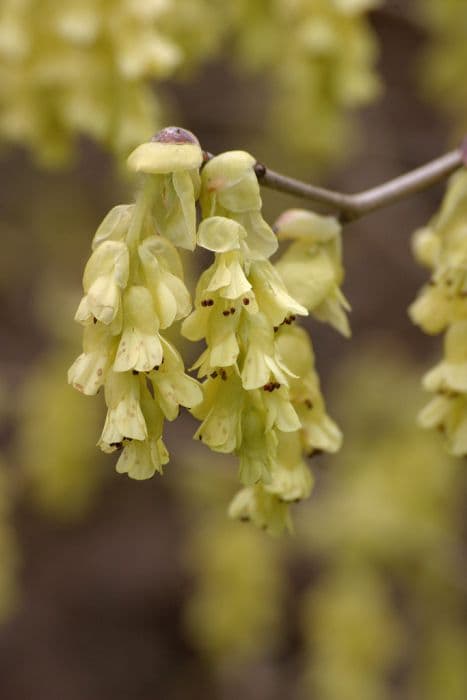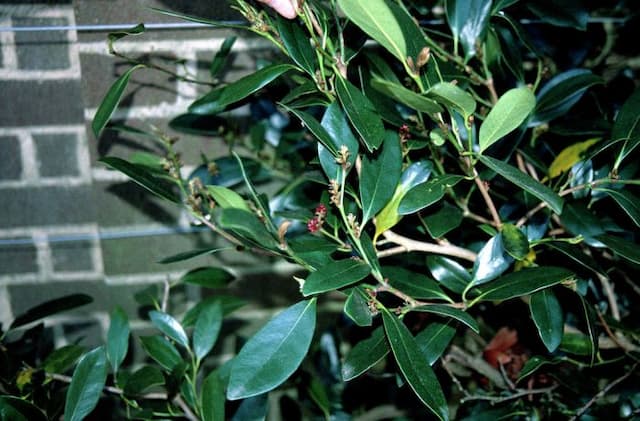Vernal Witch Hazel Hamamelis vernalis 'Sandra'

ABOUT
The plant commonly known as Sandra Witch Hazel, features unique and highly decorative flowers that typically bloom in late winter to early spring. These blossoms are distinctive for their ribbon-like petals that burst forth in vibrant colors, ranging from yellow to orange and red, often exhibiting all these hues simultaneously which creates a striking display against the dreary backdrop of winter. The flowers, usually fragrant, form clusters along the bare branches, providing a splash of cheerfulness during the cold months. Sandra Witch Hazel also sports ovate to broadly oval leaves that generally offer a lush green color throughout the growing season. In the fall, these leave transform into attractive shades of yellow, contributing to the plant's seasonal interest. The foliage is sometimes described as being unevenly wavy or crinkly along the edges, adding texture to the plant's appearance. With a rugged and vase-shaped growth habit, the branches of Sandra Witch Hazel extend outwards and upwards, giving the plant a somewhat open, yet somewhat dense structure. The bark is typically smooth with a gray to brown color that provides a neutral background, allowing the vibrant colors of the flowers and leaves to stand out greatly. Overall, Sandra Witch Hazel is prized for its year-round visual appeal, from the spellbinding winter blooms to the colorful autumn foliage.
About this plant
 Names
NamesFamily
Hamamelidaceae.
Synonyms
Ozark Witch Hazel, Vernal Witch Hazel, Sandra Vernal Witch Hazel.
Common names
Hamamelis vernalis 'Sandra'.
 Toxicity
ToxicityTo humans
Vernal witch hazel, including the Hamamelis vernalis 'Sandra' cultivar, is generally considered to be non-toxic to humans. There are no widely recognized symptoms of poisoning from ingesting parts of this plant. However, it's still advisable to avoid consuming plant matter that is not commonly recognized as food due to potential individual allergic reactions or digestive issues.
To pets
Vernal witch hazel, including the Hamamelis vernalis 'Sandra' cultivar, is not commonly listed as a toxic plant to pets, such as dogs and cats. Poisoning symptoms are not widely reported for this plant. However, ingestion of non-food plants can sometimes cause gastrointestinal upset in pets, so it is advisable to prevent pets from consuming this plant.
 Characteristics
CharacteristicsLife cycle
Perennials
Foliage type
Deciduous
Color of leaves
Green
Flower color
Red
Height
6 feet (1.8 meters)
Spread
10 feet (3 meters)
Plant type
Shrub
Hardiness zones
5
Native area
North America
Benefits
 General Benefits
General Benefits- Attractive flowering: Offers bright yellow blooms in late winter to early spring, providing color when most other plants are dormant.
- Winter interest: The distinctive flowers add visual appeal to the winter garden landscape.
- Fragrance: The blooms emit a subtle, pleasing fragrance, enhancing the sensory experience of the garden.
- Wildlife attraction: The flowers provide nectar for early-emerging pollinators and insects.
- Drought tolerance: Once established, it is quite tolerant to drought, reducing the need for frequent watering.
- Low maintenance: Requires minimal pruning and care once established, making it ideal for gardeners seeking low-maintenance plants.
- Multi-season interest: In addition to winter flowers, it offers attractive foliage in spring and summer, and colorful leaves in the fall.
- Adaptability: Grows well in a variety of soil types, though it prefers well-drained conditions.
 Medical Properties
Medical Properties- Anti-inflammatory: Extracts from the witch hazel plant are known for their anti-inflammatory properties.
- Astringent: Witch hazel is commonly used as an astringent to tighten skin and reduce inflammation.
- Antioxidant: The plant contains compounds that have antioxidant properties.
- Skin irritation: It is used topically to soothe skin irritation, including itching and redness.
- Hemorrhoids: Witch hazel is often used in products that help to relieve the discomfort of hemorrhoids.
- Minor bleeding: The astringent properties can help to stop minor bleeding from skin abrasions.
- Diarrhea: Some traditional medicine systems use witch hazel internally to treat diarrhea, though this is not common.
- Varicose veins: Topical applications are said to help in reducing the swelling and pain associated with varicose veins.
 Air-purifying Qualities
Air-purifying QualitiesThis plant is not specifically known for air purifying qualities.
 Other Uses
Other Uses- Natural Sunscreen Component: Extracts from witch hazel can be used in natural sunscreen formulations due to their protective properties against UV radiation.
- Insect Bites Relief: Witch hazel can be applied to insect bites to help soothe the irritation and reduce swelling.
- Jewelry Cleaner: A solution made from witch hazel can gently clean and restore the shine to delicate jewelry, except for porous stones and metals that can be damaged by water.
- Leather Cleaner: Witch hazel can be used as a natural cleaner for leather goods, helping to remove dirt and oils without causing damage.
- Natural Deodorant: The astringent properties of witch hazel make it a good base for homemade deodorants, as it helps minimize body odors.
- Plant Dye: Witch hazel leaves and bark can be used as a source for natural plant dye, providing colors varying from yellow to orange.
- Anti-Static Spray: A witch hazel-based spray can help in reducing static cling on clothes and hair without the use of harsh chemicals.
- Diaper Rash Remedy: Witch hazel can be applied to a baby's skin to help soothe and heal diaper rash, offering a natural alternative to commercial ointments.
- Varicose Veins Appearance Reducer: Applying witch hazel topically is believed by some to temporarily reduce the appearance of varicose veins, due to its astringent properties.
- Culinary Extract: Although not common, the extract of witch hazel can potentially be used in small quantities to impart a unique flavor to some culinary dishes.
Interesting Facts
 Feng Shui
Feng ShuiVernal Witch Hazel is not used in Feng Shui practice.
 Zodiac Sign Compitability
Zodiac Sign CompitabilityVernal Witch Hazel is not used in astrology practice.
 Plant Symbolism
Plant Symbolism- Renewal: Hamamelis vernalis, commonly known as Vernal Witch Hazel, typically blooms in late winter or early spring. It symbolizes the advent of new beginnings as it's one of the first plants to flower, often when snow is still on the ground.
- Healing: Witch Hazel has been used medicinally for centuries. Its extract is renowned for its anti-inflammatory and astringent properties, making it symbolic of healing and soothing of ailments.
- Protection: In some traditional beliefs, Witch Hazel is thought to ward off negative energy and is associated with protection due to its use in folk medicine and its early flowering, which suggests resilience.
- Uniqueness: As 'Sandra' is a cultivar of Witch Hazel, it can also represent uniqueness and individuality, celebrating the distinct tones of its flowers and differing from others in its species.
- Nature's Timing: Witch Hazel's blooming period reminds us of nature's clock, symbolizing that everything has its own perfect timing, often unrelated to human expectations.
 Water
WaterVernal witch hazel, the common name for Hamamelis vernalis 'Sandra,' prefers consistently moist soil but does not tolerate standing water. During the active growing season in spring and summer, water the plant deeply once a week, providing about 1 to 1.5 gallons of water per session. In the fall, as the plant prepares for dormancy, reduce watering frequency to every two weeks if rainfall is scarce. Over winter, watering can be further minimized unless there are extended dry spells, in which case a monthly deep watering might be necessary. Always check the soil moisture a few inches below the surface before watering to avoid overwatering.
 Light
LightVernal witch hazel thrives in full sun to partial shade. Ideally, plant it in a location where it receives at least 4 to 6 hours of direct sunlight per day, with some afternoon shade in regions with very hot summers. The best spot for this plant would be one with morning sunlight and protection from the intense afternoon sun to prevent leaf scorch.
 Temperature
TemperatureVernal witch hazel is hardy in a range of temperatures and can tolerate minimum temperatures down to about -20°F, making it suitable for many temperate climates. The ideal temperature range for this plant is between 30°F and 70°F. Although it can withstand colder winter temperatures, it is best to avoid planting in locations where temperatures frequently exceed 85°F, as this can stress the plant.
 Pruning
PruningPruning Vernal witch hazel is primarily for shaping and removing any dead or crossed branches, which maintains a healthy, attractive plant. The best time to prune is in the spring after the plant has finished blooming, usually between late February and early April. Pruning should be done annually, but excessive pruning is unnecessary as this plant naturally forms an appealing shape.
 Cleaning
CleaningNot needed
 Soil
SoilVernal Witch Hazel thrives in well-draining, rich, acidic to neutral soil with a pH of 5.5 to 7.0. Mixing organic material like leaf mold or compost into the soil will provide optimal growing conditions.
 Repotting
RepottingVernal Witch Hazel is generally not a potted plant, but if necessary, young plants can be repotted every few years in early spring before new growth begins.
 Humidity & Misting
Humidity & MistingVernal Witch Hazel prefers moderate humidity but is adaptable to a range of humidity levels as long as the soil moisture is appropriate for the plant's needs.
 Suitable locations
Suitable locationsIndoor
Provide bright light and cool temperatures for indoor Vernal Witch Hazel.
Outdoor
Plant in sun to partial shade, protect from strong winds for outdoor Vernal Witch Hazel.
Hardiness zone
Vernal Witch Hazel is suited for 4-8 USDA hardiness zones.
 Life cycle
Life cycleHamamelis vernalis 'Sandra', commonly known as Vernal Witch Hazel, begins its life cycle when seeds are dispersed from its parent plant, often with assistance from wind or water. Seeds undergo a period of dormancy and require stratification to break dormancy and germinate. Upon germination, seedlings establish themselves and grow into juvenile shrubs. As the shrub matures, it undergoes vegetative growth, developing characteristic broad green leaves and a sturdy woody structure. During late winter to early spring, Vernal Witch Hazel produces fragrant yellow to red flowers with distinctive ribbon-like petals. After pollination, typically by early-emerging insects, the plant sets seed in capsules that mature during summer and autumn, eventually starting the cycle anew with seed dispersal.
 Propogation
PropogationPropogation time
Late Winter-Early Spring
Hamamelis vernalis 'Sandra', commonly known as Vernal Witch Hazel, is typically propagated by softwood cuttings. The best time to take these cuttings is in late spring or early summer when new growth is still pliable but has started to harden slightly. To propagate by cuttings, a 4 to 6 inch (approximately 10 to 15 centimeters) length of stem is cut from a healthy branch. The bottom leaves are stripped off, and the cut end is dipped in rooting hormone to encourage root development. This cutting is then placed in a well-draining potting mix, ensuring that the leaf nodes where the leaves were removed are buried. The cutting should be kept moist but not waterlogged, and ideally placed under a humidity dome or in a location with high humidity to prevent excessive water loss through the leaves. Roots usually develop within a few weeks, and once established, the new plant can be transplanted to a more permanent location.









